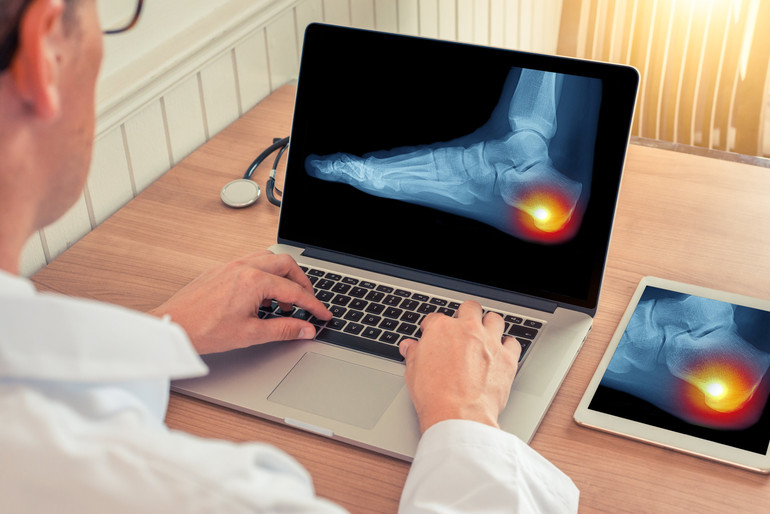The Centers for Advanced Orthopaedics is redefining the way musculoskeletal care is delivered across the region with locations throughout Maryland, DC, Virginia and Pennsylvania.
What To Expect From Heel Spur Surgery

If you’re dealing with new pain on the underside of your heel that isn’t caused by acute trauma to the area, there’s a chance you may be dealing with the formation of a heel spur. Heel spurs are the result of calcium deposits that form on the underside of your heel, and these hard formations can irritate nearby tissues and lead to pain or discomfort. Sometimes these formations can be effectively treated with footwear changes and other conservative techniques, but in today’s blog, we’re going to take a closer look at how a procedure can fix painful heel spurs.
Heel Spur Development & Symptoms
Similar to foot conditions like bunions or hammertoes, heel spurs don’t just develop overnight. Instead, they tend to form over a period of many months as a result of excessive stress on your heel. When the heel area is chronically overstressed, the fat pad on the heel can break down and the soft tissues and bone underneath can be exposed to more pressure.
This regular strain can lead to tearing of the membrane that covers the heel bone, and during the repair process, tiny calcium deposits can develop on the underside of the heel bone. If these deposits eventually get big enough, they’ll start to disrupt nearby tissues and cause pain every time you put pressure on your foot.
Chronic and excessive strain are the most common causes of heel spur formation, but that stress can come in a number of different forms. It can affect athletes who don’t take enough time off after activity, from exercise enthusiasts who are training for a marathon and putting more pressure on their feet, or it can be the result of a gait abnormality that has you putting more stress on your feet while you walk. Overweight individuals are also at a heightened risk for heel spurs because their feet inherently handle more stress when they walk, as are older individuals who naturally lose some of this protective fat pad as they age.
Symptoms of a heel spur include:
- A sharp pain with the first few steps after being immobile for a period of time.
- Dull pain when walking.
- Discomfort that comes and goes in waves.
- A pins and needles-like sensation in the heel when applying pressure.
Treating Heel Spurs With Surgery
If heel spurs have progressed to the point that they are symptomatic, you’ll want to consult with a foot and ankle specialist. There’s a chance that conservative care can provide relief if identified early enough, but we’re going to talk about how the problem can be corrected with surgery. Typically, heel spurs are addressed with one of two different procedures, each offering their own benefits.
- Interior Heel Spur Resection - The more common approach, this procedure involves removing the heel spurs after the surgeon performs a plantar fasciotomy to correct a plantar fascia that is oftentimes inflamed as a result of the presence of bone spurs.
- Posterior Heel Spur Resection - This procedure is usually performed to address heel spurs that develop near the Achilles tendon where the tendon attaches to the bone. Removing these spurs help to prevent damage to the Achilles tendon, but in rare instances the location of these spurs may also require the surgeon to address and reattach the Achilles tendon.
Both of these operations can be performed on a minimally invasive or open basis. The minimally invasive approach is less taxing on the patient and leads to faster recovery, but the open technique allows the surgeon to proceed with better visibility and ensure all problematic spurs are removed.
Most patients can be discharged from the surgical center on the same day or after 24 hours, and you’ll be asked to take it easy for a few days once you’ve returned home. Over-the-counter painkillers and icing can help limit discomfort. After about 7-10 days, you’ll have a post-op consultation where your sutures will be removed and your surgeon will see how healing is commencing. You’ll likely be limited weight-bearing for a couple weeks following the procedure, but most office workers can return to work two weeks post-op. Full recovery can take anywhere from six weeks to three months depending on if the Achilles needed to be addressed during the operation.
Heel Spur Surgeons in the DC Area
Most people experience fantastic results with heel spur surgery, but you can increase your odds by choosing a surgical team with a great track record of successfully fixing heel spurs. You can do that by trusting your care to the team at The Centers For Advanced Orthopaedics. For more information or for help with your foot or ankle issue, reach out to our team today at (703) 584-2040.